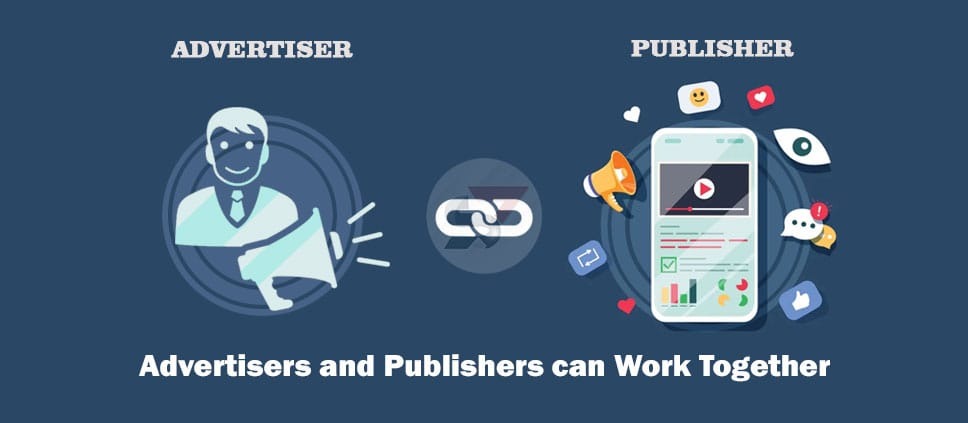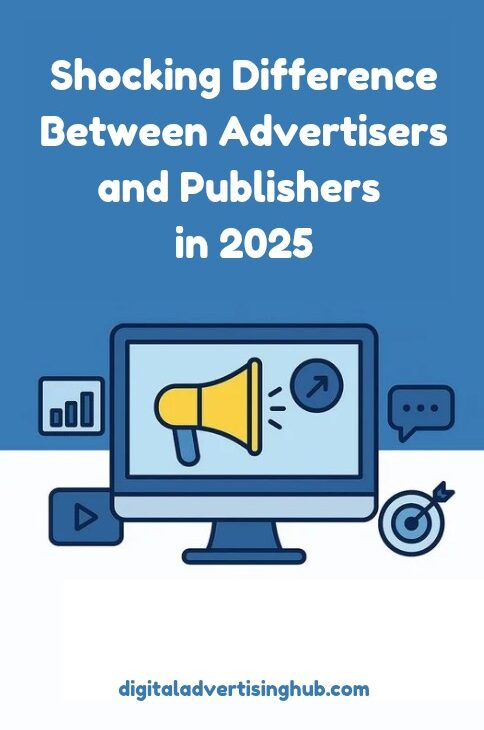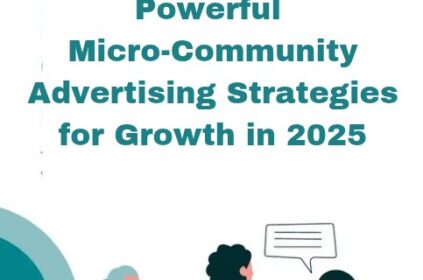The digital marketing world runs on two powerful engines: advertisers and publishers.
One fuels visibility, the other provides the road. But while both seem inseparable, their goals, roles, and payoffs couldn’t be more different.
If you’ve ever found yourself wondering which one’s right for you — the advertiser chasing conversions or the publisher monetizing content — you’re not alone.
The line between them is easy to blur, yet understanding their core differences is what separates a profitable strategy from a wasted budget.
Let’s break down what really sets advertisers and publishers apart — and how choosing the right side can define your digital success.
Understanding the Difference Between Advertisers and Publishers

In the digital advertising ecosystem, clarifying the difference between advertisers and publishers is foundational to making smart strategic decisions.
At its core, one party pays for exposure while the other provides the platform for that exposure.
An advertiser is typically a brand, company or agency that wants to promote a product, service or message to an audience.
In contrast, a publisher is the owner of ad inventory — websites, apps, blogs, podcasts or other digital media — that makes that audience available by selling or monetising space for ads.
The relationship is symbiotic: advertisers need access to audiences; publishers need monetisation of their channels.
But understanding the difference between advertisers and publishers involves more than just these broad roles.
It also touches on what motivates each party, how success is measured, the risk they assume, the tools they use, and how they collaborate.
For example, a publisher often focuses on driving high-quality traffic and maintaining engagement, while an advertiser focuses on message creation, targeting, conversion metrics and return on investment.
Why does this matter for your strategy?
If you know how to evaluate whether you should operate as an advertiser, a publisher or partner with one, you’ll be better positioned to optimise budgets, align goals, and avoid conflict or wasted spend.
In short, the difference between advertisers and publishers is not just semantic — it influences the entire structure of a digital campaign, from planning through execution and measurement.
How Advertisers vs Publishers Approach Success
When weighing the difference between advertisers and publishers, one of the first things to examine is what each side considers success.
For advertisers, the objective tends to be brand awareness, lead generation, sales, or another form of measurable conversion.
The advertiser invests budget, creative, media buy and targeting in order to reach defined business outcomes.
On the other hand, publishers focus on audience size and quality, traffic monetisation, engagement, ad inventory yield, viewability and fill rate.
Knowing this distinction helps clarify where your responsibilities or KPIs fall.
Advertisers: What they care about
Advertisers consider metrics such as cost-per-click (CPC), cost-per-acquisition (CPA), return on ad spend (ROAS), conversion rate, lifetime value (LTV) and overall campaign profitability.
They often ask: “Is this spend producing qualified leads or paying customers?”
In programmatic environments, the advertiser side is the “buy side” or demand side — seeking inventory from publishers or ad exchanges.
Publishers: What they care about
Publishers are more concerned with inventory utilisation, impressions, click-through rate (CTR) on the ads they host, eCPM (effective cost per thousand impressions), fill rate (percentage of inventory that’s sold) and traffic quality (bounce rate, engagement, user retention).
For a publisher, the question is: “How effectively am I monetising my audience and ad space?”
What this tells you
Understanding this difference means when you’re choosing between working more as an advertiser or a publisher (or selecting a partner), you’ll know which mindset and metrics to prioritise.
If you are primarily focused on pushing a product or service, then taking the advertiser role makes sense.
If you control a content asset or audience and want to monetise it, the publisher role is natural.
More nuanced still: you might do both (some companies do) which means managing both sets of metrics proficiently.
The difference between advertisers and publishers lies not just in who does what, but in how each defines and measures success.
Diving Into How Each Side Earns and Pays
Another major angle of the difference between advertisers and publishers is how revenue and risk are distributed.
When you understand this clearly, you’re better able to choose your role or partner wisely.
Advertisers: Paying to play
As an advertiser, you are spending money. You pay for creative development, media buy (ad placements), targeting, optimization, tracking, data capture and sometimes technology stack access.
You assume the upfront cost with the expectation of achieving conversions, leads, or brand lift.
If performance falls short, you bear the risk.
Research on digital ad spend shows massive volumes of budget across channels as more companies lean into online advertising.
Publishers: Getting paid for inventory or results
Publishers may be paid in different models: CPM (cost per thousand impressions), CPC (cost per click), CPA (cost per acquisition) or revenue share.
They provide the audience and space; they may invest in maintaining or growing content or platform traffic.
The risk for publishers often lies in audience engagement, ad blocking, inventory yield and ensuring traffic quality.
One summary: “An advertiser is the one who pays; a publisher is the one who gets money for showing ads.”
Shared risk and alignment
While risk and reward differ, the most efficient ecosystems are those where advertiser and publisher interests align — e.g., advertisers want genuine conversions, publishers want engaged visitors.
If the publisher’s traffic is low quality or fraudulent, the advertiser suffers. If the advertiser’s offer is weak or mis-targeted, the publisher’s yield suffers.
In such cases, the difference between advertisers and publishers becomes operational friction. Smart partnerships therefore clarify metrics, auditing, tracking and optimisation frameworks up front.
What Each Side Brings to the Table
Drilling further, the difference between advertisers and publishers often resides in what they bring.
One brings the “offer” (message, brand, product) and the other brings the “platform/traffic” (audience, content channel, distribution).
Recognising this helps you optimise which side to focus on.
Publishers: The supply side, traffic and inventory
Publishers own digital properties—websites, apps, blogs, podcasts, video channels — on which they host content and may provide ad slots (inventory) for external ads.
They build or acquire audiences and monetise those audiences by selling ad space.
In mobile marketing, a publisher is defined as “a digital property owner that sells advertising space in its property to a third party.”

Advertisers: The demand side, offer and targeting
Advertisers create the product or service proposition, craft the ad creative, define the target audience, decide on budget, select channels (which may reach publishers or ad networks), launch campaigns and measure outcomes.
They seek reach, relevance and conversion. In the ad tech stack, they are often referred to as the “demand” or “buy” side.
How it plays out together
In practical terms, the difference between advertisers and publishers can be seen when an advertiser approaches publishers (or an ad network bridging them) with a demand: “I want to reach X audience in Y geography, pay up to Z for conversions or traffic.”
Publishers respond: “Here is the traffic/slots I have, you can buy impressions/clicks or conversions at this price.” The transaction may be direct or via networks and exchanges.
Key decision implications
If you’re choosing your role, ask: Do you have an offer you want to promote (advertiser) or do you have a traffic/monetisable audience you want to exploit (publisher)?
Some organisations do both — e.g., they both run ads for their product and monetise leftover inventory.
But that dual role adds complexity and potential conflict (e.g., self-competition, cannibalisation).
Understanding the clear difference between advertisers and publishers helps you evaluate where to invest resources (creative vs traffic; message vs platform).
How the Difference Between Advertisers and Publishers Affects Execution
In today’s ad landscape, the difference between advertisers and publishers isn’t just about who pays and who hosts.
It’s about who controls data, who uses technology, who builds audience insights, who audits performance, and how trust is maintained.
Advertisers and the tech stack
Advertisers rely on tools such as demand-side platforms (DSPs), data-management platforms (DMPs), attribution platforms, tag management systems, tracking pixels, first-party data and creative optimisation.
They buy inventory programmatically, analyse performance, segment audiences and attribute conversions.
Because they shoulder the cost, they demand transparency, performance and accountability.
Publishers and the tech stack
Publishers use supply-side platforms (SSPs), ad servers, header bidding, audience analytics, view-through measurement, fill-rate optimisation, traffic quality assurance and yield management.
They must guard against fraud, ad-blocking, viewability issues and brand safety.
Publishers deliver inventory; they must provide credible traffic and data in order to attract premium advertisers.
Data sharing, transparency and conflict
The difference between advertisers and publishers often emerges when data is restricted or where there is a mismatch in metrics.
Advertisers may demand full transparency—what sites, what users, what conversions.
Publishers may protect audience data or rely on networks. This difference affects trust and partnership viability.
Some publishers may withhold granular user-level data, making advertiser optimisation harder. Networks and intermediaries can mask origins of traffic, thus complicating attribution.
The result: misaligned incentives or under-performance.
Why this matters for choosing your role
If you lean toward the advertiser side, you’ll need systems to measure conversion, attribute performance, optimize creatives, refine targeting and protect ad spend.
If you lean publisher, you’ll need to invest in audience strategy for growth, traffic quality, viewability, ad tech, yield management and compliance.
The difference between advertisers and publishers, in tech terms, is the difference between demand-side sophistication and supply-side integrity.
For many businesses, aligning with trusted partners that understand both sides can reduce friction.
When to Choose Advertising vs Publishing (or Both)
Now that we’ve explored roles, metrics, revenue models and tech stacks, it’s time to think strategically.
Given your business context, how do you choose between advertisers or publishers? When is it better to prioritise one, or handle both?
When you should favour being an advertiser
If your business has a product or service that needs visibility, you have a defined target audience, you possess a budget and creative assets, then adopting the advertiser role is logical.
You control your message and invest in channels to reach users. You want to optimize conversions, scale offers and measure ROI.
In this scenario, you consider the difference between advertisers and publishers by using publishers (or networks) to reach audiences, but you remain the advertiser driving campaigns.
When you should favour being a publisher
If your business controls a content asset, a traffic stream (blog, app, social channel), strong audience engagement, then being a publisher may make more sense.
You monetise that traffic by partnering with advertisers, selling ad space, using affiliate or native ads.
Understanding the difference between advertisers and publishers helps you craft your value proposition—“I bring X audience; you (the advertiser) bring the offer.”
This lets you optimize yield, traffic quality and monetisation.
When a hybrid model makes sense
Some organisations do both: they produce products and also monetise traffic, or have internal media properties.
While that may maximize upside, it also increases complexity—balancing internal ad placements may cannibalise external demand, data reconciliation becomes trickier, and roles may conflict.
Recognising the difference between advertisers and publishers in this hybrid model is essential — and clear governance is required.
Decision checklist
#1. Do you own the product/offer or the audience platform?
#2. Which side (buy vs sell) has your core competency and budget?
#3. Are you prepared to invest in creative and targeting (advertiser) vs traffic growth and ad tech (publisher)?
#4. How will you measure success? ROI, conversions (advertiser) or yield, CPM, fill rate (publisher)?
#5. What risks are you willing to manage—ad spend risk (advertiser) or traffic/fraud risk (publisher)?
In short, choosing between advertisers or publishers is a strategic call.
It’s not about one being “better” than the other — it’s about matching your business model, resources and goals to the role that fits.
How Advertisers and Publishers Work Together Effectively

Even when you choose one side, you will likely engage with the other side. Understanding how advertisers and publishers collaborate is therefore critical to success.
The difference between advertisers and publishers is not magnified when they work poorly — but aligned when they co-operate well.
Setting shared goals
When an advertiser partners with a publisher, both need to agree on objectives.
The advertiser wants audience relevance and conversions; the publisher wants traffic monetisation and yield optimisation.
Establishing targets, defining KPIs, tracking mechanisms and ensuring transparency mitigate friction.
The difference between advertisers and publishers becomes less about conflict and more about alignment when both sides understand each other’s priorities.
Contracting and revenue models
Agreements might be CPM, CPC, CPA, revenue-share or hybrid. The difference between advertisers and publishers is seen in who pays and who earns.
If an advertiser opts for a CPA model, the publisher bears more risk (no sale = no payment).
If CPM, the advertiser pays regardless of conversion, and the publisher may assume lower risk but the advertiser may require guaranteed metrics or minimum performance thresholds.
The right model depends on audience quality, offer strength, and trust level.
Data sharing and auditing
Trust is built when publishers provide transparent traffic sources, ad placement details, audience segments and performance data.
Advertisers may demand verification (viewability, brand safety, anti-fraud).
The difference between advertisers and publishers shows up when data is opaque — and that can raise costs, compliance risk and poor performance.
Employing independent verification, view-through metrics, and agreed-upon attribution helps.
Optimisation and iterative improvement
Collaboration should not stop after launch. The advertiser reviews conversion performance and may renegotiate or shift budget.
The publisher may optimize inventory, audience segments or format.
Recognising the difference between advertisers and publishers means accepting that their incentives differ — yet aligning them via shared dashboards, performance bonuses, or optimisation rules helps both succeed.
Conflict resolution and transparency
Common issues: advertiser complains of low quality traffic; publisher complains of low offer payout.
Setting up clear contracts, trackable metrics, frequent check-ins and hot-swap processes can lessen tension.
When both sides treat the difference between advertisers and publishers as a joint ecosystem rather than adversarial, campaigns perform better.
How to Choose Between Advertisers or Publishers
Let’s apply everything we’ve discussed in a decision scenario so you can actively evaluate your strategic direction.
Suppose you’re a business owner or digital marketing lead. You need to decide: should you operate primarily as an advertiser, become a publisher, or partner accordingly?
Step one: Assess your assets
#1. Do you have a product, service and budget to promote? That points toward the advertiser role.
#2. Do you control a content channel, have an audience, traffic or platform? That points toward the publisher role.
#3. Do you own both assets? Then perhaps you can engage in both, but be mindful of complexity.
Step two: Map your expertise and investment
#1. If you’re strong in messaging, creative, targeting and conversion funnels — your skills align with advertiser responsibilities.
#2. If you’re strong in traffic acquisition, audience growth, content, platform maintenance and monetisation — your skills align with publisher responsibilities.
#3. If neither area is strong, consider partnering with specialists. Understand how the difference between advertisers and publishers will impact your partner selection.
Step three: Choose your priority metrics
#1. As an advertiser you’ll focus on CPA/ROAS, conversion tracking, funnel optimisation.
#2. As a publisher you’ll focus on eCPM, fill rate, audience growth, traffic quality.
#3. Ensure your business model sets appropriate benchmarks for each side.
Step four: Choose your business model
#1. Advertiser: allocate budget to reach audiences, select placements (via publishers/ad networks), optimise creatives.
#2. Publisher: allocate resources to traffic growth, audience segmentation, inventory management, and then sell placements or network monetisation.
#3. Hybrid: combine roles — monetise your own traffic for your own offer and sell excess inventory. But ensure you manage cannibalisation and complexity.
Step five: Execute partnerships
If you are an advertiser using publishers, select publishers whose audience aligns with your target. Agree on terms—CPC, CPA, CPM, revenue share.
Use transparent tracking and auditing. If you are a publisher, choose advertisers that match your audience and maintain quality; negotiate fair compensation; monitor performance and fraud.
Recognising the difference between advertisers and publishers allows you to align incentives, set realistic expectations and avoid common pitfalls (e.g., paying for traffic that doesn’t convert, or delivering traffic that doesn’t meet advertiser criteria).
By following this structured framework, you’ll better position yourself to decide your role or select partners, and thereby drive stronger outcomes.
Conclusion
In summary, the difference between advertisers and publishers is a fundamental concept in digital marketing that carries practical implications for strategy, execution and success.
Advertisers bring the offer, pay for exposure, chase conversions and control creative and targeting.
Publishers bring the audience and ad inventory, focus on monetisation and traffic quality, and supply the platform for reach.
Recognising this difference gives you clarity about roles, metrics and priorities.
When deciding whether you should operate as an advertiser or publisher (or partner with one), map your assets, expertise, metrics and business model.
Ensure you understand what each side brings to the table, the revenue models, the technical stack, the data requirements, and how the collaboration works.
The landscape is evolving, with hybrid models, programmatic automation and privacy changes further blurring lines — but the foundational difference between advertisers and publishers remains.
Choose your side equipped with insight, clearly defined objectives, and aligned partnerships — and you’ll avoid the common pitfalls of mis-matched roles, unclear goals or wasted spend.
Whether you are launching a campaign or monetising your content, that difference shapes how you succeed.










